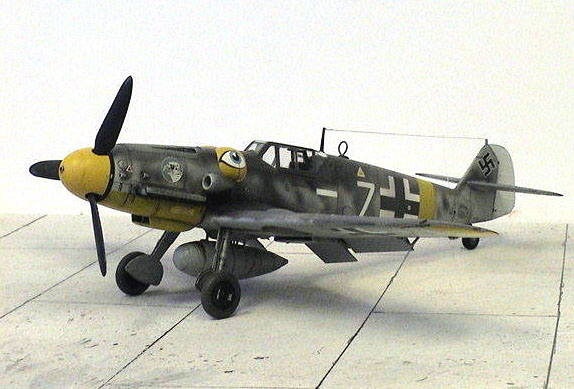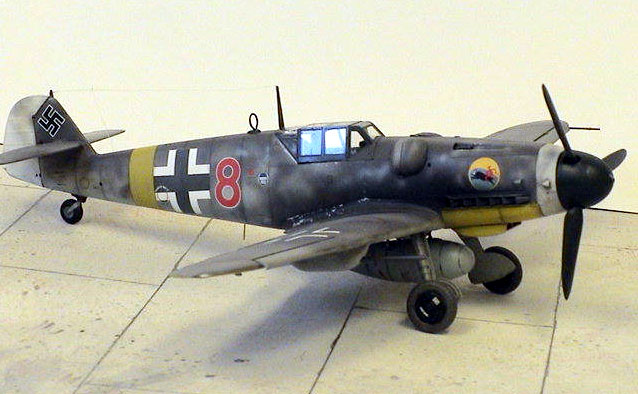|
Messerschmitt Bf
109G-6
by Jerry Crandall
|

|
|
Messerschmitt Bf 109G-6
W. Nr. 163269, Kuhlein, II./JG 51 |

Hasegawa's 1/32 scale Bf 109G-6 and
EagleCals Decals
are available online from Squadron.com
Introduction
Here are two of Hasegawa's 1/32 scale Messerschmitt Bf
109G-6 built straight from the box. This is a beautifully accurate model that
presented no serious problems during assembly, and looks very impressive when
finished.

EagleCals decals were used for both kits. The markings for
"White 7" come from EC#38, while the decals on the night fighter
"Red 8" of I./JG 302(above) are included on sheet number EC#37.
General Notes
Hasegawa's 1/32 scale Bf 109 was very easy and fun to
build. I built these two models in a total of 65 hours and of course I cut
corners (please don’t look into the cockpit!) as the primary purpose was to put
them together, paint them and try out some of our new decals which worked out
beautifully.
Taking the time to build the kit properly will result in a
very fine, accurate looking Bf 109G-6.
Kit High Points
In my opinion, some of the high points include:
-
The overall fit is excellent
-
The clever kit engineering with
the spar piece fitting into the belly pan of the fuselage allowed for the
separate wings to be slipped on and glued in place without any guesswork. This
way the dihedral is automatically preset.
-
The landing gear leg attachment
is similar to the real aircraft. The assembly is rugged and lines up
automatically to the correct angles.
-
The horizontal tail has the left
and right molded onto the interlocking tabs so when these are attached they slip
together and lock into place and again, are lined up automatically.
Areas Requiring Improvement
Some areas that I think could be improved, and probably will be through
aftermarket products:
-
The tail wheel and yoke are
molded in two halves and have to be glued together. This does not correctly
represent the yoke. It would be nice to have the yoke and the wheel/tire
separate.
-
The rear fuselage and tail
assembly can be a problem when gluing it to the main part of the fuselage. If
you are not very careful you can end up with an unsightly step, especially left
to right.
-
The canopy is beautifully molded
and crystal clear but I found, even after dry fitting, when I glued the three
piece canopy to the fuselage, it didn’t fit very well with the center section
closed. I had to remove some plastic from the center section.
-
When attaching the short antenna
mast to the rear portion of the canopy, it has a tendency for the mast to be
slanted too far forward.
Markings
Notes about the markings and camouflage of the two aircraft that I built:
“White 7” 4./JG 51 (see title photograph)
This is the well-known aircraft flown by Elias Kuhlein
depicted here in its earlier version with all-Yellow spinner, Yellow rumpf band
and Yellow wing tips, as it was flown in May 1944 based on unpublished photos.
The version in our decal sheet based on published photos
depicts this a/c as it was in June 1944 in Bulgaria with the sectioned spinner,
Yellow wing tips and rumpf band over painted. Since the overall a/c was faded
and worn, I over sprayed the completed model with a misting of light Gray to
reduce the contrast of the camouflage and markings.
“Red 8/Black 8” (see thumbnails below)
This very interesting aircraft was flown by 2./JG 302 in
February 1944 at Helsinki Finland as a night fighter protecting this area from
Russian bombers.
Other 2. Staffel aircraft were known to have Red numbers
but in the photo of this aircraft the number appears as if it might be Black. I
decided to use the Red as an alternate as out profile on the decal sheet is
depicted as Black, both are included on the decal sheet.
The overall camouflage appears to be very dark and the White nose band and
rudder have been muted. Both of these attributes reflect the aircraft's night
fighter duty. The canopy framework was factory painted in RLM 66 Dark Gray. The
rare JG 302 “Wilde Sau” emblem is on both sides of the cowling, and depicts a
Red devil riding a wild boar.
Click the
thumbnails below to view larger images:
Model, Images and Text Copyright © 2001 by
Jerry Crandall
Page Created 24 December, 2001
Last Updated 10 January, 2002
Back to HyperScale
Main Page
Back to Gallery Index
|
Home
| What's New |
Features |
Gallery |
Reviews |
Reference |
Forum |
Search